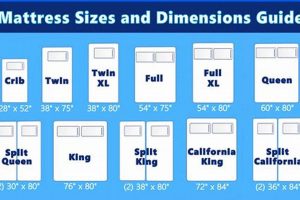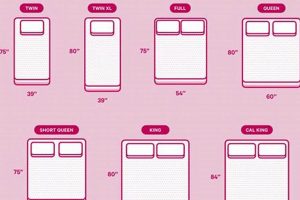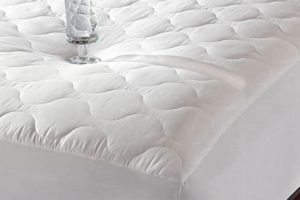Determining the dimensions of a mattress is a fundamental process when selecting bedding, purchasing new linens, or assessing bedroom layout. The precise measurements dictate the appropriate size of sheets, comforters, and bed frames. For instance, a full-size mattress requires different bedding than a queen-size mattress, and using incorrectly sized linens can lead to discomfort or damage. Knowing the exact dimensions of a sleep surface ensures compatibility with accessories and furniture.
Accurate mattress size identification is important for budgeting when looking to replace it, or buy a new one. This can prevent purchasing errors and save on potential return shipping costs. Historically, mattress sizes have evolved alongside changing living spaces and consumer preferences, reflecting trends in bedroom design and household composition. Understanding these standard sizes simplifies the consumer experience and ensures compatibility across different brands and manufacturers.
This article will cover the various methods for determining mattress size, including measurement techniques, identification of standard sizes, and resources for further verification. The following sections will provide detailed guidance to ensure accurate and informed mattress size identification.
How to Tell Mattress Size
Accurately determining mattress dimensions is crucial for purchasing correct bedding and ensuring compatibility with existing or new bed frames. These tips provide practical guidance for precise size identification.
Tip 1: Measure the Mattress Dimensions: Use a measuring tape to determine the length, width, and height (thickness) of the mattress. Ensure the tape measure is straight and taut across the surface. Accurate measurement requires consistent application from edge to edge.
Tip 2: Consult Manufacturer Labels: Locate the manufacturer’s label, typically found sewn onto the mattress. This label often indicates the mattress size, model number, and other relevant specifications. Confirm label information against measured dimensions.
Tip 3: Refer to Bed Frame Specifications: If a bed frame is already in use, consult its specifications for compatible mattress sizes. Frame dimensions usually correlate directly with standard mattress sizes. Note: This is only accurate if the bed frame is the size you think it is.
Tip 4: Compare Measurements with Standard Size Charts: Compare the measured dimensions against standard mattress size charts to identify the closest matching size. These charts are readily available online or in bedding stores. Standard sizes include Twin, Twin XL, Full, Queen, King, and California King.
Tip 5: Account for Mattress Sagging or Expansion: Over time, mattresses can sag or expand, altering their original dimensions. Consider this factor when measuring older mattresses. Measurements should be taken along the sleeping surface, if possible, to minimize the effects of any sagging.
Tip 6: Check Seam-to-Seam Measurement: When measuring, ensure the tape measure extends from seam to seam, capturing the full surface area. This avoids inaccuracies arising from rounded edges or quilted surfaces.
Tip 7: Note Specialty Mattress Sizes: Be aware that some mattresses come in non-standard or custom sizes. This is often the case for antique beds, RV mattresses, or hospital beds. Such mattresses will necessitate tailored measurements and bespoke bedding solutions.
Applying these tips will increase the reliability of mattress size determination, leading to informed purchasing decisions and avoiding the inconvenience of incompatible bedding or bed frames.
The subsequent sections will address common misconceptions about mattress sizing and provide resources for further assistance.
1. Measurement accuracy
Measurement accuracy forms the cornerstone of correct mattress size identification. Inaccurate measurements can lead to mismatched bedding, ill-fitting bed frames, and overall consumer dissatisfaction. The reliance on precise dimensions necessitates a thorough and methodical approach.
- Tape Measure Calibration
The tool used for measurement directly impacts accuracy. A worn or damaged tape measure can introduce errors. Calibration involves verifying the tape measure against a known standard, ensuring its markings align with established units of length. An uncalibrated tool will produce measurements that deviate from the true dimensions. This will cause a misfit and potentially result in financial loss.
- Consistent Technique
Variations in measurement technique can produce inconsistencies. Its important to maintain a consistent level of tension on the tape measure, avoiding both excessive slack and undue stretching. Measurements should be taken along the center of each side, minimizing the effects of any rounded edges or uneven surfaces. Inconsistent technique is a source of error in mattress size identification.
- Accounting for Protrusions and Recesses
Mattresses often feature protruding edges, pillow tops, or recessed seams. Accurate measurement must account for these features. The tape measure should follow the contours of the mattress, capturing the full extent of its dimensions, rather than simply measuring the flat surface. Neglecting these features will lead to an underestimation of overall size.
- Multiple Measurements and Averaging
To minimize the impact of random errors, take multiple measurements along each dimension. Calculate the average of these measurements to arrive at a more precise value. This practice reduces the influence of any single aberrant reading and provides a more representative assessment of the mattress size.
The facets of measurement accuracy highlight the importance of precision in mattress size determination. Accurate assessment of physical parameters is a prerequisite for successful identification, influencing compatibility with bedding and frames. Therefore, emphasizing accurate and repeatable techniques is beneficial.
2. Manufacturer's label
The manufacturer’s label serves as a primary resource for mattress size identification, offering direct information from the source. This eliminates the need for manual measurement and provides an authoritative reference point.
- Location and Content
Typically sewn onto the mattress, the label contains essential details such as the nominal mattress size (e.g., Queen, King), model number, and potentially, the exact dimensions in inches or centimeters. The label is generally found near a corner or along a side seam. Absence or illegibility of this label necessitates alternative methods of size determination.
- Standard Size Confirmation
The manufacturer’s label will often state the standard size of the mattress. For example, the label might clearly state “Queen Size.” Cross-referencing this information with standard mattress size charts confirms the accuracy of the label and provides a baseline for further verification if discrepancies arise.
- Model Number Significance
The model number on the label can be used to access detailed product specifications from the manufacturer’s website or customer service. These specifications often include precise dimensions, material composition, and warranty information. Model numbers are especially helpful for verifying the size of less common or custom-sized mattresses.
- Discrepancy Resolution
If measured dimensions deviate from those indicated on the manufacturer’s label, the label should be considered the more reliable source, especially if the mattress is new. Significant discrepancies warrant contacting the manufacturer for clarification, as this may indicate a manufacturing error or a mislabeled product.
The manufacturer’s label offers an efficient and reliable method for discerning mattress size, providing a convenient alternative to manual measurement. Utilizing the label’s data in conjunction with standard size charts enhances confidence in size identification.
3. Frame compatibility
Frame compatibility is intrinsically linked to mattress size identification. A mismatch between the mattress dimensions and the bed frame can lead to instability, reduced support, and accelerated wear. Accurate mattress size determination is, therefore, essential for ensuring proper frame integration.
- Internal Frame Dimensions
The internal dimensions of a bed frame must precisely accommodate the corresponding mattress size. These dimensions, often slightly larger than the nominal mattress size to allow for easy fitting, are critical. For example, a queen-size bed frame should have internal dimensions designed to hold a standard queen-size mattress measuring approximately 60 inches wide by 80 inches long. A frame with incorrect dimensions will result in either a mattress that is too loose and shifts, or one that is too tight and cannot be properly installed.
- Support Structure Alignment
The support structure of a bed frame, including slats, platforms, or box springs, must align correctly with the mattress dimensions to provide adequate support and prevent sagging. Gaps or uneven spacing in the support structure can lead to uneven weight distribution and premature mattress degradation. Ensuring that the support structure is designed for the specific mattress size is paramount for longevity and comfort. Furthermore, a correct, aligned structure ensures warranty validity with most mattress companies.
- Headboard and Footboard Considerations
The headboard and footboard of a bed frame should be appropriately sized for the mattress, both aesthetically and functionally. Overhang or excessive gaps between the mattress and these components can detract from the overall appearance and potentially create safety hazards. Precise mattress size identification allows for selection of headboards and footboards that are proportionate and secure, enhancing both the visual appeal and structural integrity of the bed.
- Specialty Frame Compatibility
Certain bed frames, such as adjustable bases or platform beds, require specific mattress types and dimensions for optimal functionality. Adjustable bases, for example, necessitate mattresses that are flexible and compatible with bending and articulation. Platform beds, on the other hand, may require specific mattress heights to maintain the desired aesthetic. Determining the exact mattress size and type is essential for ensuring compatibility with these specialty frames.
In summary, successful mattress size identification is pivotal for ensuring harmonious integration with a bed frame. By carefully considering the internal dimensions, support structure, headboard and footboard compatibility, and the requirements of specialty frames, consumers can avoid costly errors and ensure a comfortable and durable sleep environment.
4. Standard dimensions
Knowledge of standard dimensions is fundamental to the process of determining mattress size. Standard dimensions act as a benchmark against which physical measurements are compared, enabling classification into established categories such as Twin, Full, Queen, King, and California King. Without understanding these standard dimensions, accurate mattress size identification becomes significantly more challenging, potentially leading to the selection of incompatible bedding or bed frames. For example, a mattress measuring 74 inches in length and 38 inches in width is most likely a Twin, as those dimensions closely align with the established standard. Deviation from these measurements suggests a non-standard or custom size.
The practical application of standard dimension knowledge extends to online purchasing and communication with retailers. When ordering bedding online, specifying “Queen size” is only effective if the vendor and consumer share an understanding of the accepted queen dimensions. Similarly, when inquiring about bed frames, stating the desired mattress size allows sales associates to immediately filter options and present compatible models. Retailers and manufacturers base their product specifications on these agreed-upon standard dimensions, ensuring consistency across various brands and models. Recognizing that a “Full” mattress, also known as a “Double,” typically measures 54 inches wide by 75 inches long, enables informed decision-making during purchasing and helps avoid returns due to size incompatibility.
In summary, standard dimensions are integral to effective mattress size determination. They provide a necessary framework for categorizing, communicating, and ultimately selecting appropriately sized products. The challenges associated with identifying non-standard mattress sizes underscore the importance of adhering to standard dimensions whenever possible, streamlining the selection process and minimizing the risk of incompatibility. Understanding and applying standard dimensions simplifies the mattress and bedding purchasing experience, ensuring compatibility and overall satisfaction.
5. Sagging allowance
The consideration of sagging allowance is paramount when determining the size of an older mattress. Over time, mattresses experience wear and tear, leading to a reduction in their original dimensions. This phenomenon, commonly referred to as sagging, directly impacts the accuracy of measurements taken to determine the mattress size. Ignoring sagging allowance can result in the incorrect identification of the mattress, leading to the purchase of ill-fitting bedding or bed frames. Sagging allowance highlights the dynamic nature of mattress dimensions, indicating that a mattress’s current measurements might not align with its initial specifications. A queen-size mattress, originally measuring 60 inches by 80 inches, may measure 58 inches by 78 inches after several years of use due to compression and sagging. Attempting to purchase a queen-size sheet set based on the reduced dimensions may lead to a poor fit and overall dissatisfaction.
Failure to account for sagging can lead to practical difficulties when replacing a mattress. For example, if a consumer relies on the reduced dimensions of a sagging king-size mattress to purchase a new one, they may inadvertently select a smaller size that does not adequately fill the existing bed frame. This creates gaps, reduces support, and compromises the overall comfort of the bed. When assessing an older mattress, it is advisable to measure the depth of the sagging and add those dimensions back to the current length and width to estimate the original size. This allows for a more informed decision when purchasing a replacement.
In conclusion, sagging allowance constitutes a critical component of accurate mattress size determination, especially for older mattresses. By recognizing and accommodating the dimensional changes caused by sagging, consumers can avoid purchasing errors, ensure proper fitting of bedding and bed frames, and optimize their sleep environment. A failure to consider sagging introduces inaccuracy into the measurement process, potentially leading to significant inconvenience and additional expenses. Therefore, a methodical approach to measuring mattresses should always incorporate an assessment of wear and tear, with appropriate adjustments made to reflect the original, intended dimensions.
6. Seam-to-seam
The principle of measuring seam-to-seam is intrinsically linked to accurate mattress size determination. Because mattresses are constructed with seams defining the perimeter of the sleeping surface, this measurement method offers a standardized approach to identifying the precise dimensions. This approach mitigates potential errors introduced by measuring only the upholstered surface, which might not extend to the true edge of the mattress core. Measurement from seam to seam captures the maximum usable area, directly influencing the selection of properly sized bedding and bed frames. Neglecting this consideration can lead to ill-fitting sheets and inaccurate assessments of space requirements. For example, a mattress advertised as “Queen size” might, when measured inaccurately across the plush topping, appear smaller than the standardized 60 inches by 80 inches. This error can prompt the selection of queen-size sheets that are, in fact, too small to properly fit the mattress, leading to sheet slippage and discomfort.
The practical significance of adhering to seam-to-seam measurement is evident in various real-world scenarios. When purchasing fitted sheets, precise dimensions are critical to ensure that the elasticized edges can adequately grip the mattress corners. An inaccurate measurement, failing to account for the full seam-to-seam dimension, can result in sheets that are perpetually pulling off the mattress. Similarly, when selecting a bed frame, manufacturers design their products to accommodate mattresses with specific seam-to-seam measurements. A bed frame intended for a queen-size mattress, measured accurately from seam to seam, will provide the necessary support and stability. Using the mattress surface only can lead to purchase errors.
In conclusion, seam-to-seam measurement serves as a foundational technique for accurate mattress size identification. Its application minimizes the impact of surface variations and ensures that the true dimensions of the mattress are captured. This practice is fundamental to avoiding purchasing errors and guaranteeing a comfortable, well-fitted sleep environment. While challenges may arise when measuring mattresses with unusual seam constructions, the seam-to-seam approach remains a reliable method for linking mattress dimensions to the broader theme of standardized sizing and compatibility with bedding and bed frames.
7. Specialty sizes
The classification of mattresses beyond standard dimensions introduces complexities into the determination of size. The presence of non-standard or custom-sized mattresses necessitates specialized measurement techniques and a nuanced understanding of sizing variations.
- RV Mattresses
Recreational vehicles often feature unique mattress dimensions to maximize space utilization. RV mattresses can deviate significantly from standard sizes, requiring precise measurement to ensure compatibility with the limited space available. Failing to accurately determine the size can result in a mattress that is either too large to fit or too small to provide adequate sleeping space. A standard Full-size mattress will not typically fit in an RV. A consumer must consider its limitations.
- Antique Bed Mattresses
Antique beds frequently predate the establishment of standardized mattress dimensions. Consequently, mattresses for antique beds typically require custom sizing to match the unique dimensions of the frame. Measurement of the bed frame’s interior dimensions is essential for ordering a properly fitting mattress. This is especially important for older beds.
- Hospital Bed Mattresses
Hospital bed mattresses are designed with specific dimensions and features to accommodate patient needs. While often similar in length to Twin or Twin XL mattresses, their width and construction may differ significantly. Accurate size determination is crucial for compatibility with hospital bed frames and for ensuring patient comfort and safety.
- Custom-Made Mattresses
Custom-made mattresses offer the ultimate flexibility in size and shape. These mattresses are tailored to meet specific customer requirements, whether for oddly shaped rooms, unique bed frames, or individual comfort preferences. Determining the size of a custom-made mattress involves precise measurements of the intended sleeping area, followed by consultation with a mattress manufacturer to finalize the specifications.
Accurate size identification for specialty mattresses demands careful attention to detail and a willingness to deviate from standard sizing conventions. When dealing with non-standard mattress sizes, the process of determining the appropriate dimensions necessitates meticulous measurement and, in some cases, collaboration with mattress specialists to ensure optimal fit and comfort.
Frequently Asked Questions
This section addresses common inquiries regarding mattress size identification. These questions and answers provide clarification on best practices and potential pitfalls.
Question 1: Where is the most reliable place to find the mattress size?
The manufacturer’s label, typically sewn onto the mattress itself, represents the most authoritative source. It often includes the nominal size designation, such as “Queen” or “King,” along with specific dimensions.
Question 2: How does mattress thickness factor into determining size?
Mattress thickness, while relevant for aesthetic considerations and bed frame compatibility, does not define the nominal size. The length and width are the primary determinants of size classification.
Question 3: If a mattress is slightly larger or smaller than standard dimensions, what does that mean?
Deviations from standard dimensions suggest a non-standard or custom-sized mattress. This warrants precise measurement and consideration of specialty bedding options.
Question 4: Is it possible to determine mattress size based solely on the number of sleepers it accommodates?
While the number of sleepers can provide a general indication, it is not a reliable method for accurate size determination. Physical measurements are essential for precise identification.
Question 5: Does mattress size vary between different manufacturers or brands?
While most manufacturers adhere to established standards, slight variations in dimensions may exist. Consulting the manufacturer’s specifications for the specific model is advisable.
Question 6: What role does the bed frame play in determining the mattress size needed?
The bed frame’s internal dimensions dictate the compatible mattress size. Measuring the interior of the frame or consulting the frame’s specifications is crucial for selecting the appropriate mattress.
In summary, accurate mattress size identification relies on a combination of measurements, label verification, and an understanding of standard dimensions. When encountering deviations or uncertainties, consulting manufacturer resources is recommended.
The subsequent section will present a comprehensive guide to resources for further assistance with mattress size determination.
How to Tell Mattress Size
This article has thoroughly explored “how to tell mattress size,” emphasizing the importance of accurate measurement, manufacturer label verification, bed frame compatibility, understanding of standard dimensions, accommodation for sagging, precise seam-to-seam assessment, and awareness of specialty sizes. Each element contributes to a systematic approach for correct mattress identification.
Accurate mattress size determination is crucial for informed purchasing decisions and ensuring compatibility with bedding and bed frames. Adhering to the methodologies outlined herein minimizes the risk of errors and promotes a comfortable, well-fitted sleep environment. Continued diligence in applying these techniques ensures long-term satisfaction and avoids unnecessary expenses associated with incorrect sizing.


![Best Queen Size Mattress with Boxspring [Deals!] Organic & Natural Mattress Buyer’s Guide: Non-Toxic Sleep Solutions Best Queen Size Mattress with Boxspring [Deals!] | Organic & Natural Mattress Buyer’s Guide: Non-Toxic Sleep Solutions](https://mattressworldpa.com/wp-content/uploads/2025/07/th-2253-300x200.jpg)
![Futon vs Reg Mattress Size: Are They The Same? [Guide] Organic & Natural Mattress Buyer’s Guide: Non-Toxic Sleep Solutions Futon vs Reg Mattress Size: Are They The Same? [Guide] | Organic & Natural Mattress Buyer’s Guide: Non-Toxic Sleep Solutions](https://mattressworldpa.com/wp-content/uploads/2025/07/th-2252-300x200.jpg)



